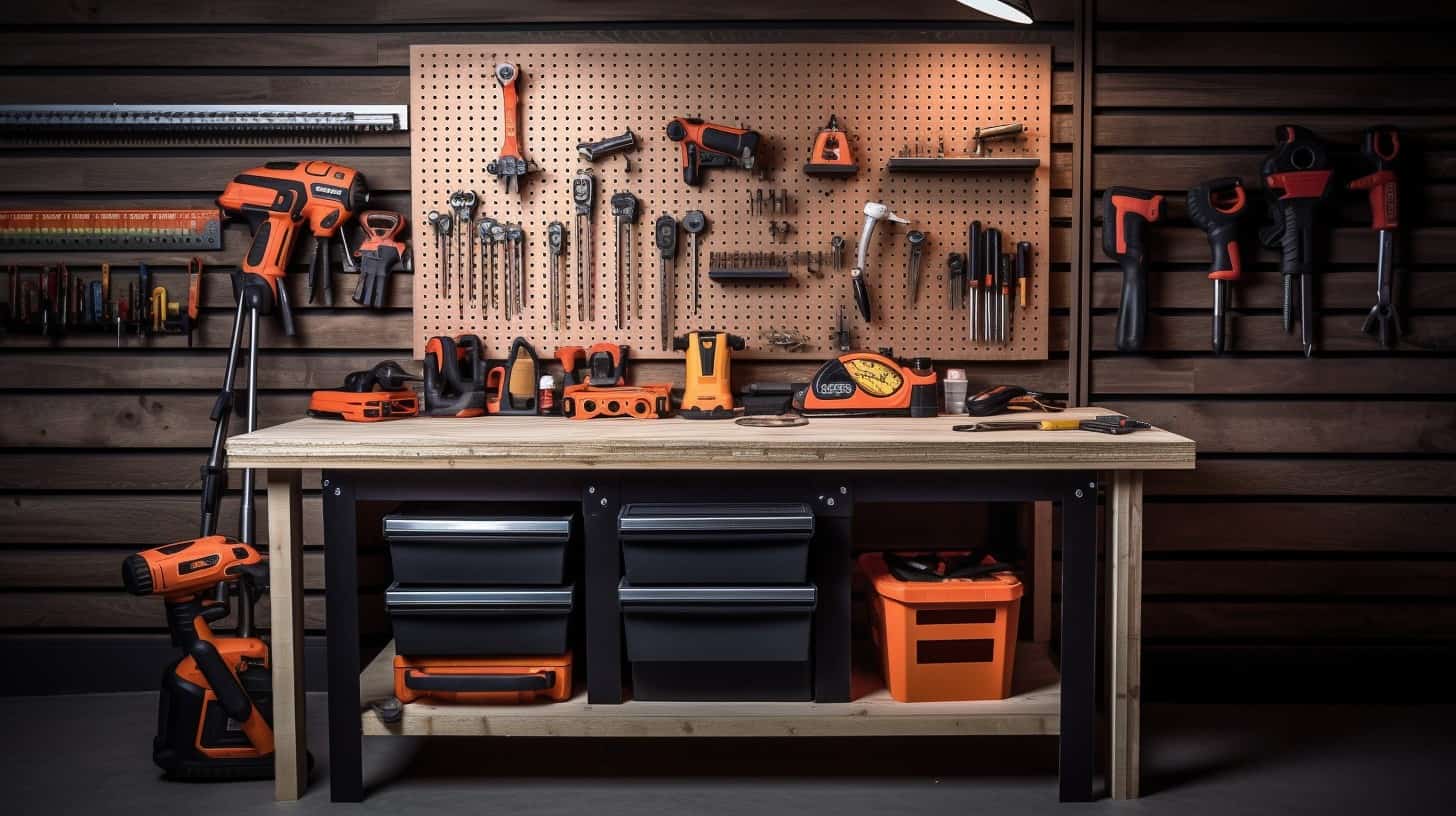Beginning a new DIY project can be quite daunting, especially when you’re greeted with a cluttered heap of tools that don’t seem to belong together. I know the feeling all too well — hunting for that elusive wrench amidst a disorganized spread of odds and ends can be downright exasperating! After sifting through my own topsy-turvy stash of implements and conducting extensive research, I’ve unearthed an array of key tools that are game-changers for any undertaking.
Let’s jump into this guide to assemble your ideal toolbox so you can approach your projects with poise and assurance.
Key Takeaways
Stock up on basic tools like adjustable wrenches, hammers, screwdriver sets, measuring tapes, pliers, utility knives, and LED shop lights to tackle most home repair tasks.
Use power tools like cordless drills, circular saws, and jigsaws for bigger projects that need more strength and precision than hand tools can provide.
Specialty tools such as stud finders and levels ensure your work is accurate and secure; they are essential when mounting or hanging items on walls.
Table of Contents
The Fundamental Tools for Everyday Fixes
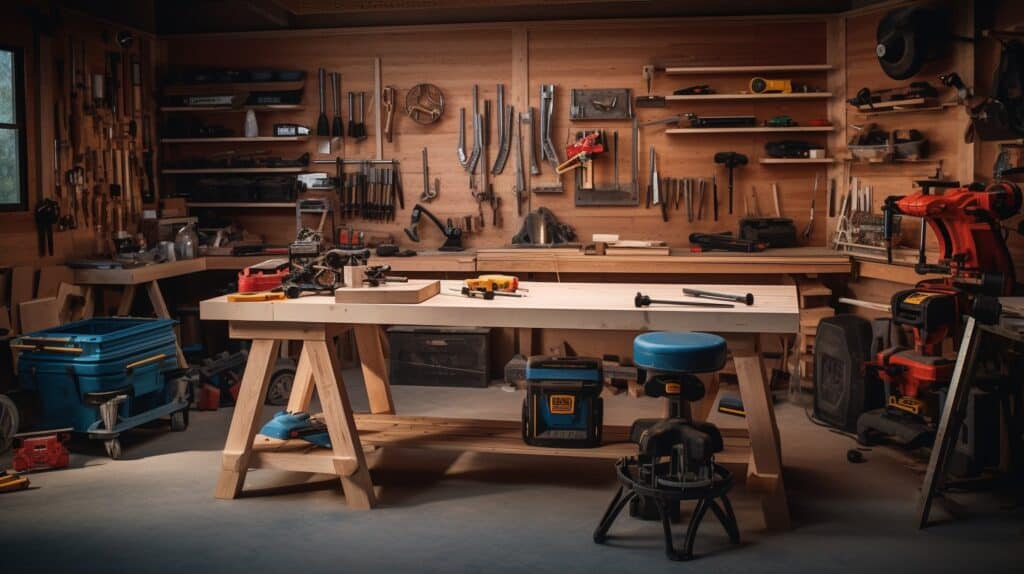
Every DIY enthusiast knows that success hinges on having the right tools for the job – and it all starts with stocking up on those indispensable fundamentals. Grab an adjustable wrench to tackle nuts and bolts, a trusty hammer for driving nails or breaking down materials, a comprehensive screwdriver set to fit any head size you encounter, a measuring tape for precision cuts, pliers for gripping and bending wires, a utility knife to make clean slices through various materials, and don’t forget bright LED shop lights so you can see what you’re doing every step of the way.
These basics form the backbone of your toolkit, setting you up to handle most home repairs with ease.
Adjustable Wrench
I’ve got to tell you about the adjustable wrench – it’s a real game-changer in my DIY toolkit. This tool is super handy because you can change its size to fit different nuts and bolts.
Imagine having one tool that does the job of many. It makes tightening or loosening just about any bolt a breeze, which is perfect for those small fixes around the house.
Think about all those times you’re under the sink or trying to put together some furniture. Instead of hunting down the right size spanner, I just grab my trusty adjustable wrench and get to work.
Its versatility really shines through when I’m tackling home maintenance tasks without a hitch. Having this tool means I’m ready for almost anything that needs twisting or turning!
Hammer
A hammer really is a must-have in your toolbox. Think about all the things you do, like hanging pictures or fixing a fence – they’re simpler with a good claw hammer by your side.
Hammers have been around for over 3 million years because they work! With one end to drive nails and another to pull them out, it’s super versatile. Got a new art piece or need to put together some furniture? Grab that claw hammer and get it done.
You’ll use this tool again and again for projects big and small. Now, let’s talk screwdrivers, the next heroes in our DIY toolkit.
Screwdriver Set
I need to tell you about screwdriver sets. They’re a must-have in any toolbox. The DEWALT 10-Piece Screwdriver Set is one of my favorites because it offers both quality and variety.
You want different sizes and types at your fingertips for all kinds of jobs, from tiny screws in electronics to big ones holding furniture together.
Magnetic tips are super helpful, too. They keep the screws stuck to the tip so they don’t fall off when I’m trying to get them into tight spots. Trust me, investing in a high-quality set like Klein Tools 85078 Cushion-Grip saves time and cuts down on headaches.
And always put them back where they belong after you’re done; that way, they’ll last longer and be ready when you need them again.
Now, let’s talk about another essential tool – measuring tape.
Measuring Tape
Measuring tape is a must-have in my toolkit. It’s perfect for making sure that everything fits right and looks good when I’m working on a project. Whether I’m hanging shelves or building a new coffee table, my measuring tape is the first tool I grab to get exact sizes.
This simple gadget makes DIY work much easier. I always double-check my numbers to avoid any mistakes. Trust me, there’s nothing worse than cutting a piece of wood too short because you guessed instead of measured! So, grabbing that measuring tape means getting it right the first time and saving myself from extra trips to the hardware store.
Pliers
I always have pliers on hand for my DIY projects. They’re a must-have because they do so many things. My needlenose pliers are great for small wires and electronic stuff, while my tongue and groove pliers grip all sorts of shapes tightly.
Locking wrenches come in handy when I’m holding bolts or pulling out stubborn fasteners.
A good tip is to get the 10″ Knipex Cobra Water Pump Pliers. They’re strong and help me a lot with plumbing jobs around the house. Every guy needs a set of these in their toolkit; they make tightening and loosening so much easier.
After sorting out your pliers, it’s smart to grab your utility knife next—a sharp blade always cuts through problems!
Utility Knife
After talking about pliers, let’s cut to the chase with another must-have: the utility knife. This tool is a true DIY hero. It slices through cardboard, trims edges, and cuts open caulking with ease.
Think of it as your go-to for quick fixes where bigger saws just won’t do.
Keep a utility knife handy because it’s perfect for those times you need to make precise cuts without fussing over larger equipment. Its sharp blade makes cutting smooth and easy, while its protective coating keeps things safe and lasts longer.
Both everyday tasks and special projects are no match for this versatile cutter that every man should have in his toolkit.
LED Shop Lights
Just as a sharp utility knife slices through materials with ease, LED shop lights cut through the darkness to brighten up your workspace. These lights are key for making everything you do in your shop clearer and safer.

We all know that trying to work in a dimly lit area is like trying to catch fish without any bait – it’s just not going to work out well.
LED shop lights give off a lot of light and use less power than old-fashioned bulbs, so they save you money on electricity bills. They slap the shadows away, letting you see every detail of your project.
Without good lighting, even simple jobs can turn into big headaches really quickly. So hang some bright LEDs over your workbench and watch how much easier it is to get things done right the first time.
Power Tools for the DIY Enthusiast
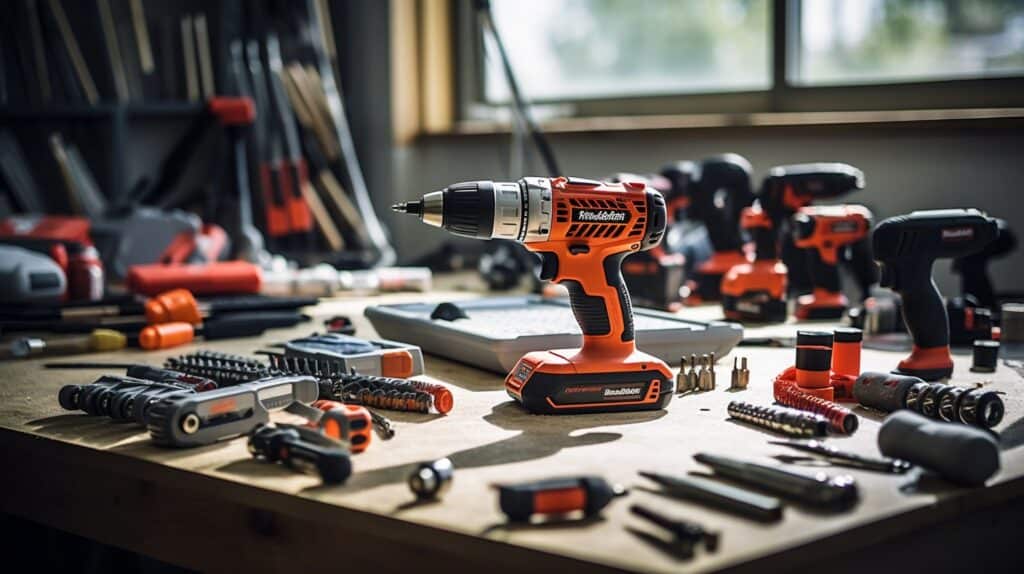
Unleash your inner craftsman with power tools that transform planks into furniture and sheets into shelters; the cordless drill, circular saw, and jigsaw are game changers for every project.
Next, discover how these tools elevate DIY from a hobby to an art form.
Cordless Drill
I love my cordless drill, and you will, too! It’s the superhero of power tools for any DIY project. Cordless drills are super handy because you can carry them anywhere without dealing with cords.
They’re perfect for putting things together and making holes in walls to hang pictures or shelves.
With a cordless drill in my hand, I feel ready to tackle any job around the house. From screwing together flat-pack furniture to fixing loose door hinges, it gets the work done fast and right.
Plus, swapping out different drill bits is a breeze—so whether I’m working with wood or metal, I’ve got it covered!
Circular Saw
I have a circular saw in my toolkit because it’s a game-changer for making quick, straight cuts in wood or other materials. This powerful tool is perfect for slicing through plywood sheets, chopping up 2x4s, and tackling all sorts of construction tasks with ease and precision.
Its blade spins fast to cut smoothly without wasting time.
Keeping safety in mind is crucial when I grab my circular saw. I always wear safety goggles to protect my eyes from flying debris. A good tip is to use a guide when cutting to keep the line straight and avoid any slips.
Plus, since it’s lightweight and portable, I can take it wherever the job needs doing—whether that’s fixing something on the porch or putting up new shelves indoors. It turns tough jobs into simple tasks and saves a bunch of time compared to using hand tools.
Jigsaw
A jigsaw is a game-changer for cutting shapes in wood or metal. It’s one of those power tools that can handle curves, circles, and detailed cuts with ease. Think about turning complex tasks into something quick – that’s what a jigsaw does.
Always keep safety in mind; wear goggles and work slowly to stay in control.
Some top-notch models from trusted brands make all the difference. With the right jigsaw, DIY projects jump from good to great because it slices through materials like a pro. Talk about saving time and getting smoother results! Whether crafting a birdhouse or customizing furniture, this tool helps you cut out just what you need without a fuss.
Cordless Impact Driver
I’ve got to tell you about the cordless impact driver. It’s like having a superhero in your tool belt for all those tough-to-tackle screws and bolts. This dynamo delivers serious torque and speed, so whether I’m putting together some new furniture or working on my deck, it never lets me down.
The freedom of no cords means I can twist and turn into all those awkward spots without a hitch.
Choosing the right one is key; trust me, brands like DEWALT, Milwaukee, and Makita know their stuff when it comes to long-lasting performance. And this little powerhouse plays well with others – team it up with a reciprocating saw next time you need to slice through metal or wood.
Now that we’ve powered through that, let’s talk about specialty tools for the unique jobs around the house.
Specialty Tools for Specific Tasks
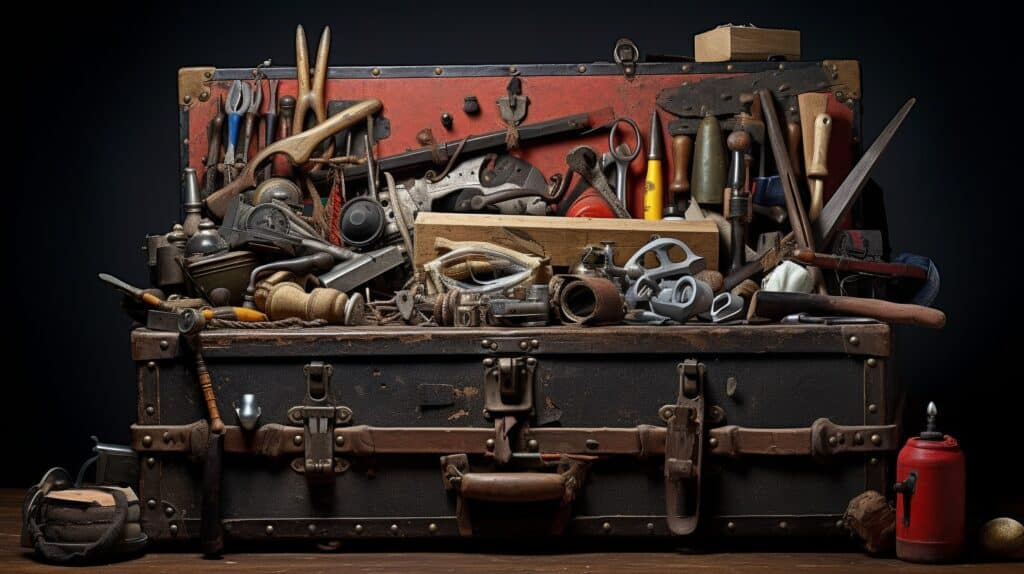
Whether you’re installing a fancy new chandelier or ensuring your priceless family photos hang straight, specialty tools like the stud finder and level take the guesswork out of these tasks.
Wire strippers simplify electrical jobs, and a comprehensive socket wrench set gives you leverage for nuts and bolts in every shape and size. These purpose-specific items might not see daily action but are worth their weight in gold when precision is key.
Stud Finder
I always make sure to grab my stud finder before I start hanging things on the wall. It’s a game-changer for home improvement projects. Imagine trying to mount a TV or put up shelves without knowing where your support is – that’s asking for trouble! Stud finders come in handy forms like magnetic ones, which latch onto metal fasteners inside studs, or electric types that sense changes in wall density.
My go-to is the Zircon StudSensor e50; it nails accuracy and is simple to use. You just run it over the wall, and boom; you know exactly where to drill without hitting electrical wires or pipes – because who wants those kinds of surprises? And let’s talk about the Franklin Sensors ProSensor 710.
This beast can spot several studs at once! But here’s a pro tip: calibrate your tool each time for spot-on results. Some stud finders even have extra features like sensing live AC wires or metals behind walls, giving me extra peace of mind during any DIY adventure.
Level (Spirit Level or Laser Level)
Finding studs is just the start. You also need to make sure everything you build or hang is perfectly level. That’s where a spirit level or laser level comes in handy. These tools are key for tasks like hanging pictures, putting up shelves, or setting up kitchen cabinets.
A spirit level uses a bubble in a liquid to help you see if things are straight. But let me tell you about the laser level – it’s like having an extra set of hands! It shoots out a bright line that sticks to walls or travels across the room.
This means surfaces can be lined up with incredible accuracy without guesswork. For serious DIY work, having one of these levels is essential to make sure every project looks great and stays put for good.
Wire Strippers
Leveling things out is one thing, but now let’s talk about something just as essential: wire strippers. Having a good pair in your toolbox means you’re ready to tackle wiring tasks safely and efficiently.
They come at different price points from $4 to over $100, so you can find the right ones that fit your budget.
Wire strippers are really handy for a lot of projects like woodworking, metalworking, and fixing stuff around the house. These tools grab onto a wire’s insulation and cleanly peel it off without damaging the metal inside.
This makes them super important when you’re working with anything electrical because messing up wires isn’t just annoying – it could be dangerous. Keep these in your kit, and you’ll be set whenever there’s wiring work to do.
Socket Wrench Set
After talking about wire strippers, let’s move on to another must-have: the socket wrench set. This tool is my go-to for a bunch of tasks around the house and garage. Think about changing oil, putting together new furniture, or fixing things on your car.
A socket wrench set makes these jobs much easier because it has so many different sizes and shapes to fit bolts and nuts.
I’ve got this in my toolbox because it’s super handy for all kinds of DIY stuff, like building with wood or making general home fixes. It gives me what I need to handle repairs and build cool things without a hitch.
Trust me, having a good socket wrench set means you’re ready to tackle anything from small tweaks to big projects that come up.
Safety Gear for Personal Protection
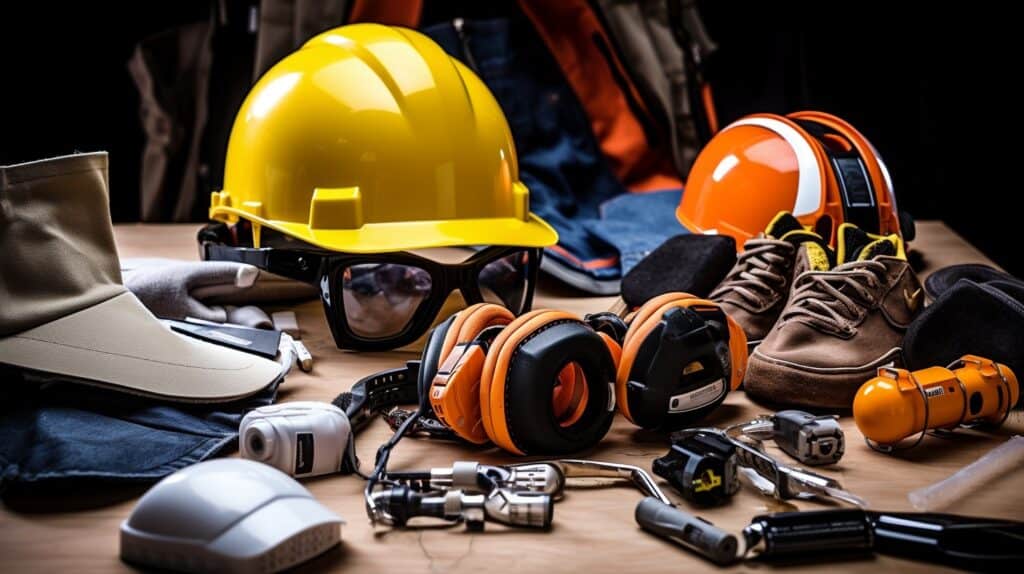
As we dive into the array of DIY tasks, it’s crucial not to overlook safety gear for personal protection. Sporting a pair of sturdy safety goggles can shield your eyes from harmful debris, while ear protection dampens the roar of power tools, preserving your hearing.
Don’t forget work gloves; they are essential for gripping and safeguarding against splinters and cuts. And in dust-laden environments or when dealing with chemicals, a reliable dust mask or respirator is vital for maintaining clear lungs.
Remember: starting any project equipped with proper protective gear is just as important as having the right tool in hand.
Safety Goggles
I always make sure I’ve got my safety goggles on before I start any DIY project where things might fly around. You never know when a piece from sawing or drilling could hit your eye.
These goggles only cost 11 bucks, but they’re priceless when it comes to keeping my eyes safe.
It’s smart to wear them, not just for the big jobs with electric drills and circular saws, but also for simpler tasks like hammering nails or chopping wood. Safety first is my motto because you can’t do the job right if you’re hurt.
Plus, they keep dust and debris out of your eyes, which means fewer breaks and a job done faster.
Ear Protection
Just like you protect your eyes with safety goggles, don’t forget about your ears. Loud noises from power tools can hurt them. Ear protection keeps your hearing safe when you’re around noise that is louder than 85 decibels.
Think of a chainsaw or a big drill – those are really loud and can damage your ears over time.
You might want to get something like the 3M Peltor Sport Tactical 100 earmuffs. They fit well on your head, feel comfortable for a long time, and cut down on noise by 22 decibels. The cool part is they let you still hear people talking and other sounds around you that aren’t too loud.
This way, you can work safely without missing out on what’s happening nearby.
Work Gloves
I need to tell you about work gloves, because they keep your hands safe. You might not think about them much, but trust me, when you’re sawing wood or dealing with wires, you’ll be glad you have them on.
They’re a big deal in the DIY world. Your pair of gloves protects from cuts, scrapes, and even burns.
Gloves also help you hold things better. No more tools slipping out of your sweaty hands mid-job! Make sure to pick a tough pair that can stand up to rough stuff and fit snugly on your hands.
You want to move freely without worrying about blisters or splinters ruining your day – or project! Remember this tip: safety first means always wearing those gloves for personal protection during any project.
Dust Mask or Respirator
Breathing in dust and tiny bits from my projects isn’t just uncomfortable; it’s bad for my health. That’s why I always keep a good dust mask or respirator handy. It makes sure the air I breathe is clean, even when I’m sawing wood or sanding drywall.
The right fit is super important, too, because if my mask doesn’t seal properly on my face, that dirty air can sneak in.
Choosing the best kind of mask depends on what I’m doing. If there’s a lot of dust, like from sheetrock or sawdust, a simple dust mask might do. But for nastier stuff like fumes from paint or chemicals, I go for a sturdier respirator to really protect my lungs.
Safety first – this way, I can focus more on getting the job done well and less on coughing up sawdust! Next up are some tips to keep everything organized so you don’t lose track of your tools while you work.
Organizational Must-Haves
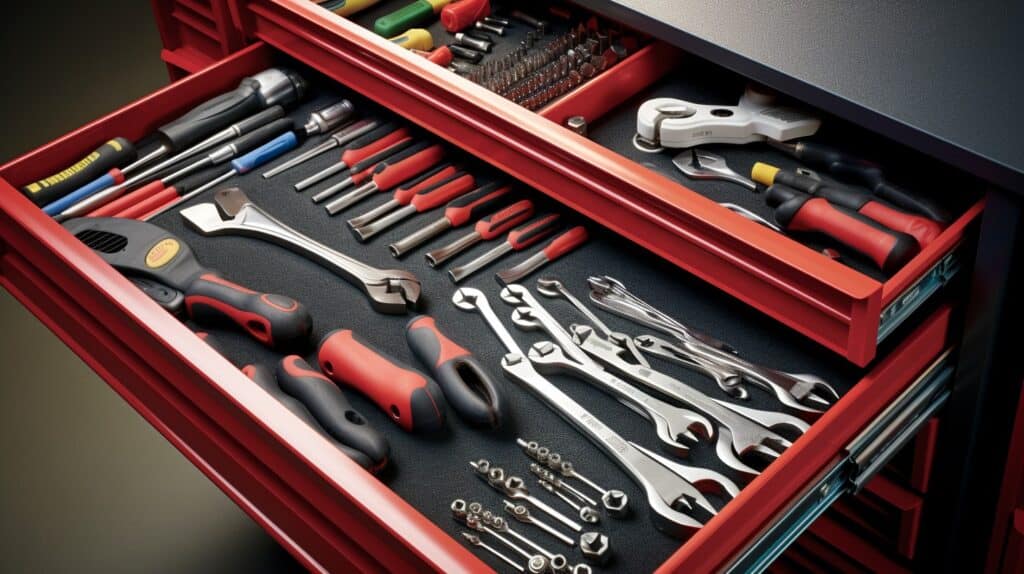
6. Organizational Must-Haves: Master your workspace with savvy storage solutions like toolboxes and pegboards—it’s time to transform chaos into order for streamlined projects. Dive deeper to discover how clutter becomes a thing of the past!
Tool Box or Tool Belt
Having a toolbox is like having a treasure chest for all my gear. I keep everything organized so I can find what I need fast. It holds all kinds of tools, big and small, and it’s perfect for storage in my garage or workshop.
Now, let’s talk about the tool belt. This thing is a game-changer when I’m moving around fixing stuff. It straps on, and I’ve got quick access to the most important tools without running back and forth.
Whether climbing ladders or crawling under sinks, it keeps my hands free but my tools ready.
Wall Organizers or Pegboards
I keep my tools on wall organizers and pegboards. They’re awesome for making sure everything has its place. No more digging through drawers or losing a screwdriver just when I need it.
They hang right there on the wall, easy to see and grab.
These racks are great because they can change as my tool collection grows. I can move hooks around and fit different sizes of tools without any trouble. Plus, having my gear out in the open cuts down on accidents since I’m not tripping over stuff left on the floor.
It’s a smart move to snap up some pegboards for your space, too.
Portable Workbench
Moving from organizing tools on walls or pegboards, let’s talk about a portable workbench. This is something I can’t do without for my projects when I don’t have a fixed spot to work in.
It’s like having a mobile workshop that I can set up anywhere, whether in the garage, backyard, or even at a friend’s house.
A portable workbench provides me with a firm place to handle all sorts of tasks – cutting wood, drilling holes, or putting parts together. Its clever design often includes places to store my tools and materials, which helps me keep everything neat and within reach.
And the best part? When I’m done, it folds up and goes right back into storage until next time. This kind of flexibility makes it an essential piece of gear for any man who loves DIY but doesn’t have the space for a huge setup.
Outdoor and Gardening Essentials
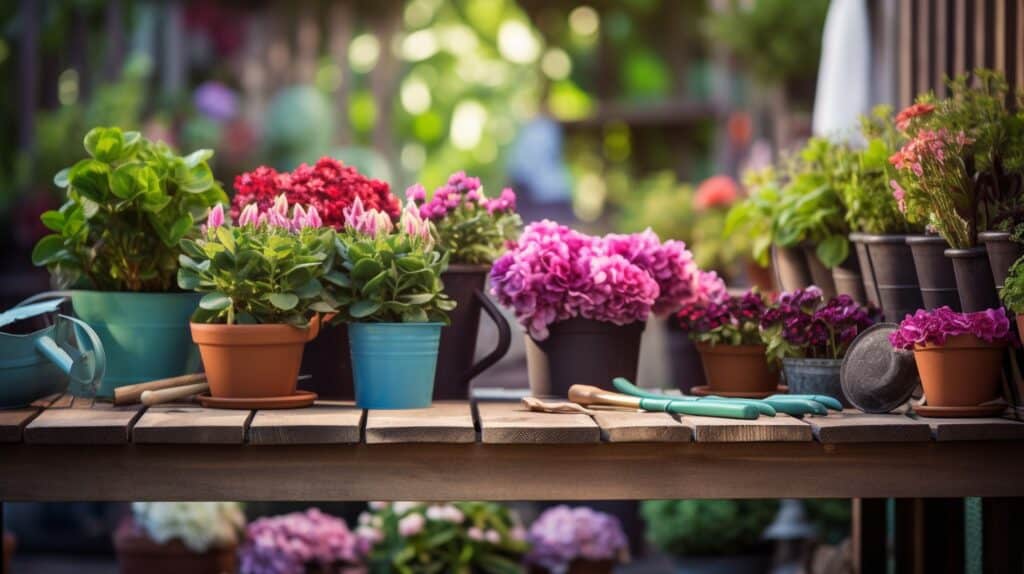
When you venture outside, have the right gear on hand. Your outdoor toolkit should include a sturdy gardening pruner or bypass lopper for controlled trimming; a robust shovel is indispensable for digging and transplanting.
Don’t overlook a flexible hose and various watering tools to keep your garden flourishing. These essentials empower you to tackle any yard task with confidence.
Gardening Pruner/Bypass Lopper
I’ve got a gardening pruner and bypass lopper, and trust me; they’re lifesavers for keeping my yard looking sharp. The pruner is perfect for quick snips here and there, taking out dead or unwanted branches with ease.
It’s a must-have to make sure the plants in my garden stay healthy and grow right.
Now, let’s talk about the bypass lopper. This tool is all about power and precision when it comes to shaping hedges or cutting thicker limbs that are tough to handle. With this in hand, I can tackle larger projects without straining my back or arms too much.
Both these tools keep my outdoor space neat and encourage strong plant growth—it’s like giving your green pals a good trim so they look their best!
Shovel
Every guy tackling outdoor projects needs a trusty shovel in his toolkit. You’ll find me reaching for mine, whether digging up dirt, moving gravel, or clearing snow from the walkway.
Shovels are key because they do heavy lifting with less strain on your back.
You know that feeling of trying to dig into tough soil with a weak tool? Forget about it! A sturdy steel blade cuts right in, but if you want something lighter, aluminum or fiberglass handles are the way to go.
They don’t just make the job easier; a good shovel lasts longer and works better when cared for properly—just give it a clean and sharp edge.
Now, let’s shift gears and talk about hoses and watering tools. After all, what’s a garden without water?.
Hose and Watering Tools
After you’ve got your shovel for digging, it’s time to talk about keeping those plants alive. That’s where hose and watering tools come into play. For any yard or garden task, a good quality hose makes a big difference.
You can water your plants, wash off your tools, and even give the dog a bath with it.
You’ll want to look for hoses that are strong but flexible and get one long enough to reach all parts of your yard without dragging it too much, which can be tough on it. And don’t forget about the nozzle; having one with different settings helps you control the flow of water so you can mist delicate flowers or blast dirt off your deck.
For bigger jobs or more precise watering, consider getting watering cans or an irrigation system that can do the work while you take care of other tasks on your to-do list. With costs ranging from budget-friendly to investment-worthy, there’s something out there that fits everyone’s wallet and needs for their outdoor projects.
The Modern Handyman’s Gadgets
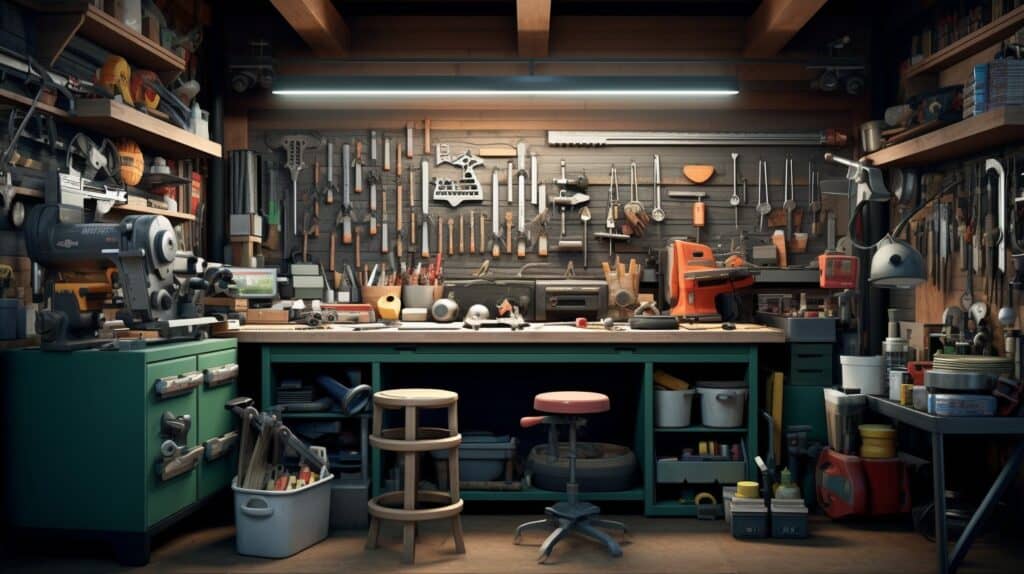
In the realm of DIY, staying on top of technological advances gives you an edge; that’s where the modern handyman’s gadgets come into play. Think digital calipers for precise measurements down to the hair’s breadth and non-contact voltage testers that keep you safe while dealing with electrical systems.
Then there’s the multimeter – your Swiss Army knife for troubleshooting all things electric. These tools aren’t just fluff; they’re game-changers, making your projects more accurate and efficient, solidifying your status as a true 21st-century craftsman.
Digital Caliper
I’ve got a game-changer for precise measurements in any DIY project: the digital caliper. This gadget is a must-have when accuracy counts. It measures inside, outside, depth, and step dimensions with spot-on precision.
Here’s the cool part – it has an LCD display that shows clear readings. You can flick between inches, millimeters, and fractions in no time. Made from tough stuff like stainless steel, these calipers are ready for action, whether you’re working with wood or metal.
They make sure every cut fits just right without any guesswork.
Non-Contact Voltage Tester
A non-contact voltage tester is essential for anyone who tackles electrical projects. It keeps you safe by letting you check wires without touching them. You just bring it close to a wire or outlet, and it tells you if there’s voltage present.
This cool little gadget lights up or beeps when it finds electricity, so there’s no guesswork involved.
It’s important to stay safe and avoid electric shocks when fixing things around the house. With this tester in your toolkit, you can quickly find out which wires are live before working on them.
Whether you’re installing a new light fixture or replacing an old switch, make sure your safety comes first with this handy tool.
Multimeter
I’ve got to tell you about a tool I won’t touch an electrical project without – the multimeter. This gadget is like having superpowers when working with wires and circuits. It lets me measure voltage, current, and resistance so accurately that there’s no second-guessing if things are wired up right or not.
With this in my hand, I can check for short circuits or see if a component isn’t doing its job anymore.
Using a multimeter means playing it safe, too. Instead of poking around guessing where the problem might be, this tool points me right to it. And since it measures both AC and DC power, plus currents big and small, I’m ready for anything from fixing a car’s electrical system to sorting out home wiring issues.
Trust me; grabbing one of these will change the game for your DIY projects – precision matters when you’re dealing with electricity!
Maintenance Tools for Longevity
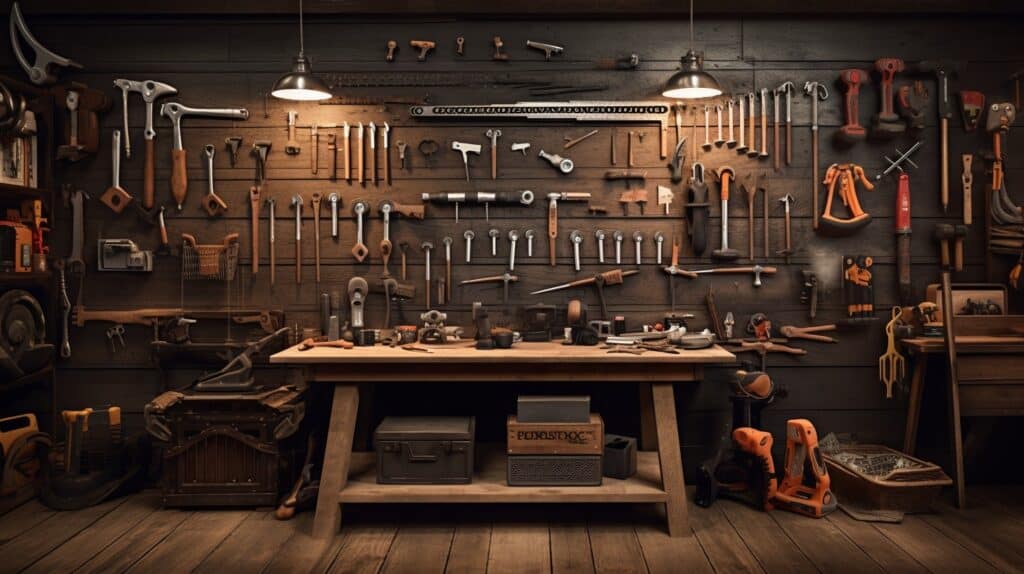
Keep your DIY arsenal in top condition with essential maintenance tools like lubricants to prevent rust, tapes for quick fixes, and sharpening implements to ensure precision cuts. Dive into the details to sustain your toolkit’s lifespan and tackle projects with confidence.
Lubricants (e.g., WD-40)
I always keep a can of WD-40 handy in my garage. This stuff is a lifesaver for keeping all my tools and equipment running smoothly. It’s not just for squeaky hinges, you know. A quick spray on the moving parts helps avoid that annoying rust and keeps things like ratchets, adjustable wrenches, and pipe wrenches working like new.
And if I come across nuts and bolts that just won’t budge due to rust, WD-40 comes to the rescue—it loosens them right up.
Lubricating with WD-40 also means I don’t have to shell out cash for new tools because it protects against wear and tear. Plus, it does an amazing job cleaning them up too! Think about it: taking care of your gear with this magic spray adds layers of defense so they last longer.
And trust me, when you’re deep into DIY projects, having smooth-operating tools makes everything easier. Now let’s talk tapes – they hold our world together in more ways than one!
Duct Tape and Electrical Tape
After talking about the importance of lubricants like WD-40 for keeping tools in tip-top shape, it’s time to discuss duct tape and electrical tape. These tapes are lifesavers in many situations.
Duct tape can fix almost anything temporarily. If I spot a hole or tear, I slap some duct tape on it, and it’s good until I can make a more permanent repair. It’s strong, sticky, and water-resistant, which makes it great for all kinds of quick fixes.
Electrical tape is another must-have in my toolbox. This type of tape wraps around exposed wires to keep them from touching each other or anything that could cause a short circuit or shock.
With its insulation power, electrical tape helps me stay safe while working on wiring projects around the house. Both types of tapes are super versatile and help me ensure everything keeps running smoothly long after the project is done.
Sandpaper and Files
Let’s talk about sandpaper and files. These aren’t just any tools; they’re the secret behind making rough edges smooth and getting surfaces ready for a sharp look. Think of them as your project’s best friends.
Sandpaper comes in all sorts of grits – that means how rough or fine it is. You’ll need different grits to tackle different jobs, from taking off old paint to finishing up with a super-smooth surface.
Now, files are the tough pals in your kit. They shape and smooth out wood or metal like nobody’s business. Got a piece that doesn’t quite fit? Grab a file and work on it until it’s perfect.
Keeping these tools around makes sure I can handle any material with confidence, knowing my DIY projects will last longer and look better because I’ve paid attention to the details.
Cleaning Supplies (e.g., Shop-Vac)
I know keeping tools in top shape is key, and that’s where a Shop-Vac comes in. It sucks up all sorts of messes and keeps my workspace neat. Sawdust, small screws, or even spills – the Shop-Vac handles it all without fuss.
A clean space means I can find what I need fast, and my tools last longer, too.
The Shop-Vac isn’t just for cleaning up afterward; it’s a DIY companion. From the garage to the workshop, it supports me through every project by making sure nothing gets in the way – literally.
Dust on power drills or saws? Gone! This powerhouse tool ensures maintenance is as easy as pie, extending the life of my entire toolkit with every use.
Conclusion: Building Your Ultimate Toolbox
Now, you’ve got the know-how for a top-notch toolbox. Remember, every project gets easier with the right tools in hand. Keep your gear tidy and ready to go; when a DIY task pops up, you’ll be set to tackle it head-on.
Protect yourself always with the right safety stuff. Your ultimate DIY toolkit is not just about getting jobs done—it’s about doing them well and safely every time.
FAQs About Essential Tools Every Man Needs
What basic tools do I need for a DIY project?
For any DIY project, you should have a tape measure, Allen keys or hex keys, screwdriver heads, a miter saw, and a table saw to cut wood. Don’t forget safety glasses to protect your eyes!
How can I join or fill gaps in my DIY work?
Use a caulking gun and joint compound with a putty knife to fill in or seal up gaps. A chalk line will help you make straight lines for cutting or aligning.
What are some tools that help with holding things together?
A staple gun is great for attaching materials like fabric or thin wood pieces. Allen wrenches tighten screws with hexagonal sockets often found in furniture kits.
Are there special saws I might use in carpentry projects?
Yes! Carpenters often use specialty saws like jig saws to cut curves, coping saws for intricate cuts, circular saw blades for smooth round cuts, and hacksaw blades for metal.
Can I find information on how to use these tools online?
Sure! You can look up how-to guides and videos on the internet using network connections from your internet service provider through email links or just searching directly.
Besides cutting and measuring, what other essential tools should men have?
Other must-haves include rubber mallets to avoid surface damage when hitting objects, shop vacs for cleaning up messes easily, moisture meters to check water content in materials before working on them, and flashlights so you can see well in dark areas.
